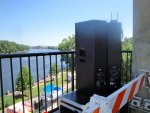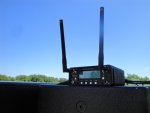 I first had a chance to use the Lectrosonics D4 system a little over two years ago at the 2010 LAB Expo in Westminster, MA. Howard Kaufman of Lectro brought it to show off, and we ended up using it to get three sub signal lines outside to play around with cardioid and end-fire arrays. Normally I wouldn't expect a wireless system to be able to deliver sub-30Hz energy, but the D4 system did it with ease.
I first had a chance to use the Lectrosonics D4 system a little over two years ago at the 2010 LAB Expo in Westminster, MA. Howard Kaufman of Lectro brought it to show off, and we ended up using it to get three sub signal lines outside to play around with cardioid and end-fire arrays. Normally I wouldn't expect a wireless system to be able to deliver sub-30Hz energy, but the D4 system did it with ease.The system uses Lectrosonics' Digital Hybrid wireless technology (US Pat #7,225,135). They have this to say about it:
Digital Hybrid WirelessTM is a revolutionary design that combines digital audio with an analog FM radio link to provide both outstanding audio quality and exemplary, noise-free RF performance.
Using a patented algorithm to encode 24-bit digital audio information in the transmitter into an analog format, the encoded signal is then transmitted over an analog FM wireless link.
At the receiver, the signal is then decoded to restore the original digital audio. This process eliminates compandor artifacts and produces an audio frequency response flat to 20 kHz.
The short story is it's a low bandwidth FM transmission link, which gives the long range of a traditional analog FM signal and can fit more information over the same link. It also offers compander free audio with an extended frequency response, no problem getting 20Hz-20kHz over it. This is the same technology that powers the TM400 system that many measurement techs use to eliminate hundreds of feet of mic cable.
The big difference is that the D4 system can send four independent channels of audio, line level analog or AES digital. Even better, it can convert between the two e.g. input AES audio and output analog. The D4 system can operate in 4 channel mode (4 MHz), or reduced bandwidth 2 channel mode (2MHz) with half the channel width and therefore twice the channel options. The whole system operates from 902-928 MHz at power levels of 200mw, so interference is less of an issue than other frequency ranges and there's plenty of juice for long throws.
Application Specifics
 When I learned I had to do a delay tower at 400' for last weekend's gig (for which I used a bunch of EAW KF760) I immediately thought of the D4 system. I emailed Howard and asked if he might have one to spare. Fortunately, he had a D4 system in a nice hard case with all the cables and everything. Not only did he send me a D4 system, he sent me a backup single channel system using their IFB transmitter and R400A receiver.
When I learned I had to do a delay tower at 400' for last weekend's gig (for which I used a bunch of EAW KF760) I immediately thought of the D4 system. I emailed Howard and asked if he might have one to spare. Fortunately, he had a D4 system in a nice hard case with all the cables and everything. Not only did he send me a D4 system, he sent me a backup single channel system using their IFB transmitter and R400A receiver.I had Howard mail the wireless directly to the shop I was working out of, and I drove a truck down full of line array. I also brought helical antennas intending to use them with the D4 system in case I had signal strength problems. What I forgot is that the D4 system uses a little screw on antenna connector, not BNC like my antennas and cabling. So much for planning ahead. The D4 manual has all sorts of warnings about using too high gain an antenna as well, so I don't know whether I could have used the helicals anyway. It sure would be nice to have the option, since getting four channels a long way is a real boon. Perhaps there is an adapter? The IFB backup system has standard BNC antenna connections, so I could have used it with higher gain antennas if I experienced a problem, but it is single channel which isn't as nice.
Fortunately, I had a reasonably clear transmission path, plus the 900MHz spectrum is relatively uncluttered, and I was in the middle of a military base with few major transmitters nearby. As a result, when I put the D4T at my delay tower site I saw almost full signal strength right off the bat. Instead of having to run hundreds of feet of XLR past vendor stalls, over foot paths, and across vehicle access, I just dropped a generator at my delay tower and took my signal over the air.
 Because I had four channels available, I sent three line array signals down the line (KF760 far, KF760 Mid, and KF730 Near) plus a sub feed directly into the ADRaudio ATA618 cardioid subs. I drove them all directly off a Dolby Lake Processor at FOH so that I could do measurement from there, and maintain control over the separate sections of the array from my tablet all over the field. Incidentally I had much more trouble keeping the tablet connected than I did getting the D4 system operational. The D4R had no apparent problem driving multiple powered subwoofers as well as two DSPs all at the same time. If I were smarter I would have asked to borrow a TM400 system as well so I didn't have to run (well, have David run) 500' of XLR across the field to do my measurements, but I'm obviously not smarter.
Because I had four channels available, I sent three line array signals down the line (KF760 far, KF760 Mid, and KF730 Near) plus a sub feed directly into the ADRaudio ATA618 cardioid subs. I drove them all directly off a Dolby Lake Processor at FOH so that I could do measurement from there, and maintain control over the separate sections of the array from my tablet all over the field. Incidentally I had much more trouble keeping the tablet connected than I did getting the D4 system operational. The D4R had no apparent problem driving multiple powered subwoofers as well as two DSPs all at the same time. If I were smarter I would have asked to borrow a TM400 system as well so I didn't have to run (well, have David run) 500' of XLR across the field to do my measurements, but I'm obviously not smarter.I was a little nervous that there would be noise, or dropouts, or perhaps problems due to the heat. I left both ends of the D4 system in direct sunlight and monitored both frequently while setting my delay times, measuring, and through sound check. That signal strength meter hardly budged, and the audio coming out was exactly as expected. If I hadn't known better I would have never known the difference between the D4 system and XLR... except of course I didn't have to run 1600' of XLR!
The D4 system seems to clip at about 0dBu (OK, that's what it says in the manual), so I padded the inputs down at the receiver by 10dB which seemed to do the trick. The meters operate over a very wide scale so it was hard to judge exactly how much headroom I had, but it seemed like even during loud sections I had as much as 10dB. Since the system was relatively noise free I stayed on the safe side and padded a little more than I might have if I was trying to wring every ounce of performance out of normal wireless. No noise, no clipping, all day. I'll have to read the manual a little more carefully to see how exactly I'm supposed to set it up to have a compatible overload point with normal pro audio gear (say, 21dBu or so?) but this worked flawlessly.
 The show itself went easily. I stopped bothering to check on the Lectrosonics gear after the sun went down, it hadn't delivered a single hiccup all day so with heat out of the question I stopped worrying about it. The show ended with fireworks, which were very well done, and the accolades of the promoter and event manager who were thrilled that we'd gotten audio to the back of the field. I was thrilled that I didn't have to wrap thousands of feet of cabling. One three person crew, myself included, could take down the delay tower and have it back on the truck while the remainder of the crew took down the main stage and its two stacks.
The show itself went easily. I stopped bothering to check on the Lectrosonics gear after the sun went down, it hadn't delivered a single hiccup all day so with heat out of the question I stopped worrying about it. The show ended with fireworks, which were very well done, and the accolades of the promoter and event manager who were thrilled that we'd gotten audio to the back of the field. I was thrilled that I didn't have to wrap thousands of feet of cabling. One three person crew, myself included, could take down the delay tower and have it back on the truck while the remainder of the crew took down the main stage and its two stacks.I really appreciated having the D4 system for this show, it made my life a lot easier and meant I could have a lot more lines of audio than I might otherwise have gotten. If it weren't this system, with performance like the TM400 wireless test and measurement system endorsed by so many expert measurement folks, I might not have gone with a wireless solution for this gig. As it was, having the ability to set my delay tower where it was convenient and not have to worry about changing cable lengths if it needed to move, damaged cables from vehicle and foot traffic, filthy cables from the same, and extra time wasted laying out and coiling long runs of XLR, was fantastic.
Knowing how well the D4 system performed at 400', which is a little long for normal delay tower use, I would happily use it at an even longer range. I would certainly like to find out about using more directional antennas, but for this application it was not an issue. Next time I need delays, or need to get full quality audio from one place to another several hundred feet apart for any reason, I sure hope I can get my hands on one of these again. The fact that the whole system fits in a tiny hard case is just another bonus. I don't know what it costs but the TM400 system is very reasonably priced, a real problem solver to be sure.


